
Prometheus Operator默认的监控指标并不能完全满足实际的监控需求,这时候就需要我们自己根据业务添加自定义监控。添加一个自定义监控的步骤如下:
1、创建一个ServiceMonitor对象,用于Prometheus添加监控项
2、为ServiceMonitor对象关联metrics数据接口的Service对象
3、确保Services对象可以正确获取到metrics数据
下面本文将以如何添加redis监控为例
部署redis
k8s-redis-and-exporter-deployment.yaml
--- apiVersion:v1 kind:Namespace metadata: name:redis --- apiVersion:apps/v1 kind:Deployment metadata: namespace:redis name:redis spec: replicas:1 selector: matchLabels: app:redis template: metadata: annotations: prometheus.io/scrape:"true" prometheus.io/port:"9121" labels: app:redis spec: containers: -name:redis image:redis resources: requests: cpu:100m memory:100Mi ports: -containerPort:6379 -name:redis-exporter image:oliver006/redis_exporter:latest resources: requests: cpu:100m memory:100Mi ports: -containerPort:9121
部署redis的同时,我们把redis_exporter以sidecar的形式和redis服务部署在用一个Pod
另外注意,我们添加了annotations:prometheus.io/scrape: "true" 和 prometheus.io/port: "9121"
创建 Redis Service
apiVersion:v1 kind:Service metadata: name:redis-svc namespace:redis labels: app:redis spec: type:NodePort ports: -name:redis port:6379 targetPort:6379 -name:redis-exporter port:9121 targetPort:9121 selector: app:redis
检查下部署好的服务并验证metrics能够获取到数据
[root@]#kubectlgetpo,ep,svc-nredis
NAMEREADYSTATUSRESTARTSAGE
pod/redis-78446485d8-sp57x2/2Running0116m
NAMEENDPOINTSAGE
endpoints/redis-svc100.102.126.3:9121,100.102.126.3:63796m5s
NAMETYPECLUSTER-IPEXTERNAL-IPPORT(S)AGE
service/redis-svcNodePort10.105.111.177<none>6379:32357/TCP,9121:31019/TCP6m5s
验证metrics
[root@qd01-stop-k8s-master001MyDefine]#curl10.105.111.177:9121/metrics
#HELPgo_gc_duration_secondsAsummaryofthepausedurationofgarbagecollectioncycles.
#TYPEgo_gc_duration_secondssummary
go_gc_duration_seconds{quantile="0"}0
go_gc_duration_seconds{quantile="0.25"}0
go_gc_duration_seconds{quantile="0.5"}0
go_gc_duration_seconds{quantile="0.75"}0
go_gc_duration_seconds{quantile="1"}0
go_gc_duration_seconds_sum0
go_gc_duration_seconds_count0
#HELPgo_goroutinesNumberofgoroutinesthatcurrentlyexist.
#TYPEgo_goroutinesgauge
go_goroutines8
#HELPgo_infoInformationabouttheGoenvironment.
#TYPEgo_infogauge
............
创建 ServiceMonitor
现在 Prometheus 访问redis,接下来创建 ServiceMonitor 对象即可
apiVersion:monitoring.coreos.com/v1 kind:ServiceMonitor metadata: name:redis-k8s namespace:monitoring labels: app:redis spec: jobLabel:redis endpoints: -port:redis-exporter interval:30s scheme:http selector: matchLabels: app:redis namespaceSelector: matchNames: -redis
执行创建并查看-serviceMonitor
[root@]#kubectlapply-fprometheus-serviceMonitorRedis.yaml servicemonitor.monitoring.coreos.com/redis-k8screated [root@]#kubectlgetserviceMonitor-nmonitoring NAMEAGE redis-k8s11s
现在切换到PrometheusUI界面查看targets,会发现多了刚才创建的redis-k8s监控项

现在就可以查询redis-exporter收集到的redis监控指标了

配置 PrometheusRule
我们现在能收集到redis的监控指标了,但是现在并没有配置监控报警规则。需要我们自己根据实际关心的指标添加报警规则
首先我们看下Prometheus默认的规则,大概如下。

现在我们就来为redis添加一条规则,在 Prometheus的 Config 页面下面查看关于 AlertManager 的配置:
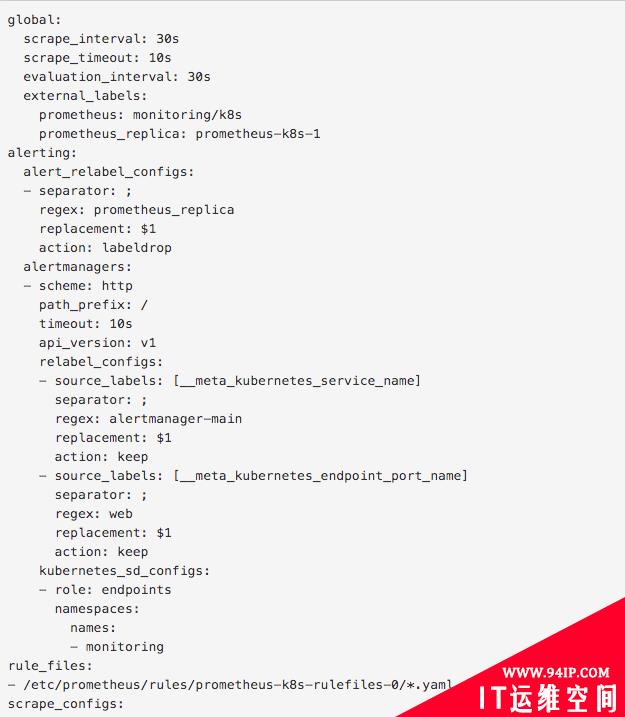
上面 alertmanagers 实例的配置我们可以看到是通过角色为 endpoints 的 kubernetes 的服务发现机制获取的,匹配的是服务名为 alertmanager-main,端口名为 web 的 Service 服务,我们查看下 alertmanager-main 这个 Service:
[root@]#kubectldescribesvcalertmanager-main-nmonitoring Name:alertmanager-main Namespace:monitoring Labels:alertmanager=main Annotations:<none> Selector:alertmanager=main,app=alertmanager Type:ClusterIP IP:10.111.141.65 Port:web9093/TCP TargetPort:web/TCP Endpoints:100.118.246.1:9093,100.64.147.129:9093,100.98.81.194:9093 SessionAffinity:ClientIP Events:<none>
可以看到服务名就是 alertmanager-main,Port 定义的名称也是 web,符合上面的规则,所以 Prometheus 和 AlertManager 组件就正确关联上了。而对应的报警规则文件位于:/etc/prometheus/rules/prometheus-k8s-rulefiles-0/目录下面所有的 YAML 文件。可以进入 Prometheus 的 Pod 中验证下该目录下面是否有 YAML 文件:

这个YAML文件实际上就是我们之前创建的一个 PrometheusRule 文件包含的:
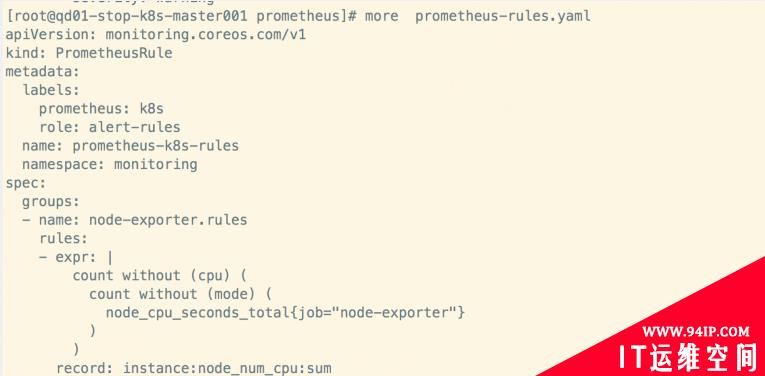
这里的 PrometheusRule 的 name 为 prometheus-k8s-rules,namespace 为 monitoring,我们可以猜想到我们创建一个 PrometheusRule 资源对象后,会自动在上面的 prometheus-k8s-rulefiles-0 目录下面生成一个对应的-.yaml文件,所以如果以后我们需要自定义一个报警选项的话,只需要定义一个 PrometheusRule 资源对象即可。至于为什么 Prometheus 能够识别这个 PrometheusRule 资源对象呢?这就查看我们创建的 prometheus( prometheus-prometheus.yaml) 这个资源对象了,里面有非常重要的一个属性 ruleSelector,用来匹配 rule 规则的过滤器,要求匹配具有 prometheus=k8s 和 role=alert-rules 标签的 PrometheusRule 资源对象,现在明白了吧?
ruleSelector: matchLabels: prometheus:k8s role:alert-rules
所以要想自定义一个报警规则,只需要创建一个具有 prometheus=k8s 和 role=alert-rules 标签的 PrometheusRule 对象就行了,比如现在我们添加一个redis是否可用的报警,我们可以通过redis_up这个指标检查redis是否启动,创建文件 prometheus-redisRules.yaml:
apiVersion:monitoring.coreos.com/v1 kind:PrometheusRule metadata: labels: prometheus:k8s role:alert-rules name:redis-rules namespace:monitoring spec: groups: -name:redis rules: -alert:RedisUnavailable annotations: summary:redisinstanceinfo description:Ifredis_up==0,rediswillbeunavailable expr:| redis_up==0 for:3m labels: severity:critical
创建prometheusrule后,可以看到我们自己创建的redis-rules
kubectlapply-fprometheus-redisRules.yaml kubectlgetprometheusrule-nmonitoring NAMEAGE etcd-rules4d18h prometheus-k8s-rules17d redis-rules15s
注意 label 标签一定至少要有 prometheus=k8s 或 role=alert-rules,创建完成后,隔一会儿再去容器中查看下 rules 文件夹:

现在看到我们创建的 rule 文件已经被注入到了对应的 rulefiles 文件夹下面了。然后再去 Prometheus的 Alert 页面下面就可以查看到上面我们新建的报警规则了:

配置报警
现在我们知道了怎么去添加一个报警规则配置项,但是这些报警信息用怎样的方式去发送呢?
这个就需要我们配置alertmanager
这里我以邮件和微信为例
alertmanager的配置文件alertmanager.yaml使用 alertmanager-secret.yaml 文件创建,这里看下默认的配置
cat alertmanager-secret.yaml
apiVersion:v1 kind:Secret metadata: name:alertmanager-main namespace:monitoring stringData: alertmanager.yaml:|- "global": "resolve_timeout":"5m" "inhibit_rules": -"equal": -"namespace" -"alertname" "source_match": "severity":"critical" "target_match_re": "severity":"warning|info" -"equal": -"namespace" -"alertname" "source_match": "severity":"warning" "target_match_re": "severity":"info" "receivers": -"name":"Default" -"name":"Watchdog" -"name":"Critical" "route": "group_by": -"namespace" "group_interval":"5m" "group_wait":"30s" "receiver":"Default" "repeat_interval":"12h" "routes": -"match": "alertname":"Watchdog" "receiver":"Watchdog" -"match": "severity":"critical" "receiver":"Critical" type:Opaque
现在我们需要修改这个文件,配置微信和邮件相关信息,前提你需要自行准备好企业微信相关信息,可以自行网上搜相关教程。
首先创建alertmanager.yaml文件
global:
resolve_timeout:5m
smtp_smarthost:'smtp.51os.club:25'
smtp_from:'amos'
smtp_auth_username:'amos@51os.club'
smtp_auth_password:'Mypassword'
smtp_hello:'51os.club'
smtp_require_tls:false
wechat_api_url:'https://qyapi.weixin.qq.com/cgi-bin/'
wechat_api_secret:'SGGc4x-RDcVD_ptvVhYrxxxxxxxxxxOhWVWIITRxM'
wechat_api_corp_id:'ww419xxxxxxxx735e1c0'
templates:
-'*.tmpl'
route:
group_by:['job','severity']
group_wait:30s
group_interval:5m
repeat_interval:12h
receiver:default
routes:
-receiver:wechat
continue:true
match:
alertname:Watchdog
receivers:
-name:'default'
email_configs:
-to:'10xxxx1648@qq.com'
send_resolved:true
-name:'wechat'
wechat_configs:
-send_resolved:false
corp_id:'ww419xxxxxxxx35e1c0'
to_party:'13'
message:'{{template"wechat.default.message".}}'
agent_id:'1000003'
api_secret:'SGGc4x-RDcxxxxxxxxY6YwfZFsO9OhWVWIITRxM'
我这里添加了两个接收器,默认的通过邮箱进行发送,对于 Watchdog 这个报警我们通过 webhook 来进行发送,这个 webhook 就是wechat。
说明我这里偷懒,因为现在系统刚好有一个报警Watchdog,所以我这里匹配了 Watchdog 这个报警,当然您可以换成我们自定义的redis的监控RedisUnavailable

然后使用在创建一个templates文件,这个文件是发微信消息的模板wechat.tmpl:
{{define"wechat.default.message"}}
{{-ifgt(len.Alerts.Firing)0-}}
{{-range$index,$alert:=.Alerts-}}
{{-ifeq$index0-}}
AlertTpye:{{$alert.Labels.alertname}}
AlertLevel:{{$alert.Labels.severity}}
=====================
{{-end}}
===AlertInfo===
AlertInfo:{{$alert.Annotations.message}}
AlertTime:{{$alert.StartsAt.Format"2006-01-0215:04:05"}}
===MoreInfo===
{{ifgt(len$alert.Labels.instance)0-}}InstanceIp:{{$alert.Labels.instance}};{{-end-}}
{{-ifgt(len$alert.Labels.namespace)0-}}InstanceNamespace:{{$alert.Labels.namespace}};{{-end-}}
{{-ifgt(len$alert.Labels.node)0-}}NodeIP:{{$alert.Labels.node}};{{-end-}}
{{-ifgt(len$alert.Labels.pod_name)0-}}PodName:{{$alert.Labels.pod_name}}{{-end}}
=====================
{{-end}}
{{-end}}
{{-ifgt(len.Alerts.Resolved)0-}}
{{-range$index,$alert:=.Alerts-}}
{{-ifeq$index0-}}
AlertTpye:{{$alert.Labels.alertname}}
AlertLevel:{{$alert.Labels.severity}}
=====================
{{-end}}
===AlertInfo===
AlertInfo:{{$alert.Annotations.message}}
AlertStartTime:{{$alert.StartsAt.Format"2006-01-0215:04:05"}}
AlertFixTime:{{$alert.EndsAt.Format"2006-01-0215:04:05"}}
===MoreInfo===
{{ifgt(len$alert.Labels.instance)0-}}InstanceIp:{{$alert.Labels.instance}};{{-end-}}
{{-ifgt(len$alert.Labels.namespace)0-}}InstanceNamespace:{{$alert.Labels.namespace}};{{-end-}}
{{-ifgt(len$alert.Labels.node)0-}}NodeIP:{{$alert.Labels.node}};{{-end-}}
{{-ifgt(len$alert.Labels.pod_name)0-}}PodName:{{$alert.Labels.pod_name}};{{-end}}
=====================
{{-end}}
{{-end}}
{{-end}}
现在我们先删除原来的 alertmanager-main secret,然后再基于alertmanager.yaml和wechat.tmpl创建alertmanager-main secret
kubectldeletesecretalertmanager-main-nmonitoring kubectlcreatesecretgenericalertmanager-main--from-file=alertmanager.yaml--from-file=wechat.tmpl-nmonitoring
上面的步骤创建完成后,很快我们就会收到一条wechat消息,同样邮箱中也会收到报警信息:
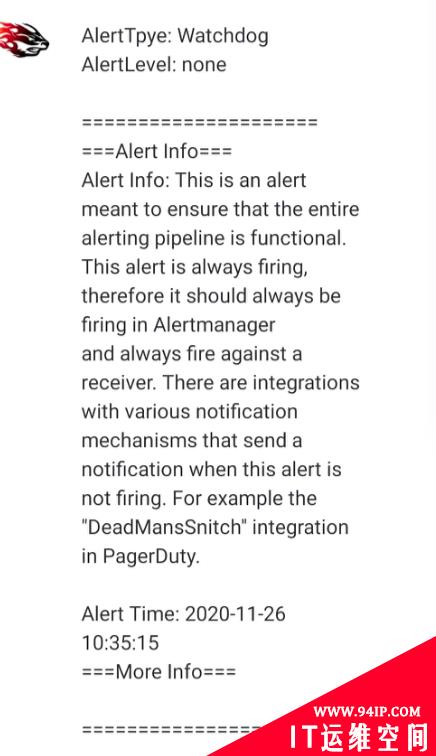
再次查看 AlertManager 的配置信息可以看到已经变成上面我们的配置信息了
转载请注明:IT运维空间 » 运维技术 » Prometheus Operator自定义监控项

![[Oracle]复习笔记-SQL部分内容](/zb_users/upload/2023/02/25/20230213095820-63ea09bc55070.jpg)






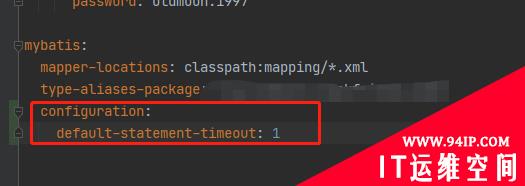







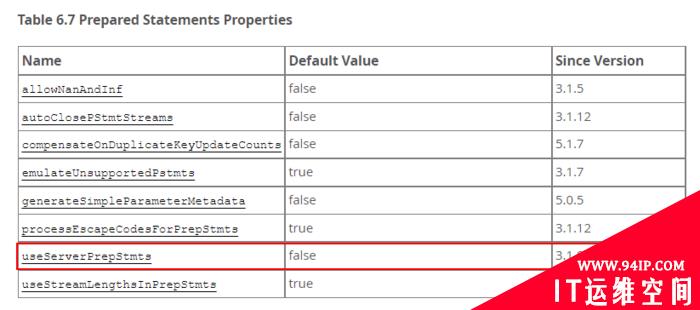





发表评论